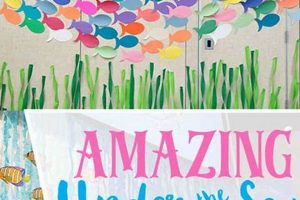Crafting personalized habitats for aquatic life involves the design and construction of aesthetic elements within a fish tank using readily available or repurposed materials. This encompasses a broad range of projects, from creating artificial rock formations and caves to fashioning plant replicas and unique background designs. An example would be constructing a miniature castle from aquarium-safe plastic or arranging driftwood to mimic a natural riverbed environment.
Such endeavors provide several advantages, including cost savings compared to purchasing commercially manufactured items. Moreover, creating personalized aquarium environments fosters creativity and allows aquarists to tailor the habitat to the specific needs and preferences of their fish. Historically, decorating aquariums has been driven by a desire to replicate the natural environments of fish, providing a sense of security and reducing stress.
The subsequent sections will delve into various methods for constructing aquarium decorations, highlighting appropriate materials, safety precautions, and design considerations to ensure a healthy and visually appealing environment for aquatic inhabitants.
Tips for Constructing Personalized Aquarium Environments
Successful creation of customized aquarium features hinges on adherence to safety guidelines and informed material selection.
Tip 1: Material Compatibility. Ensure all materials introduced into the aquarium are inert and non-toxic. Plastics should be food-grade or labeled as aquarium-safe. Avoid metals, as they can leach into the water and harm aquatic life.
Tip 2: Thorough Cleaning Procedures. Before introducing any item into the aquarium, meticulously clean it with hot water and a non-toxic scrubbing pad. Avoid soaps or detergents, as residues can be detrimental.
Tip 3: Structural Integrity. Verify that any structures constructed are stable and unlikely to collapse, potentially injuring fish or disrupting the aquarium environment. Securely bond components using aquarium-safe silicone sealant.
Tip 4: Avoid Sharp Edges. Carefully smooth any sharp edges or points on created objects to prevent injury to fish. Sanding or filing rough surfaces is recommended.
Tip 5: Gradual Introduction. Introduce new elements gradually to allow fish to acclimate to changes in their environment. Observe fish behavior for signs of stress or discomfort.
Tip 6: Water Quality Monitoring. Regularly monitor water parameters (pH, ammonia, nitrite, nitrate) after introducing novel objects. Changes in water chemistry can indicate material incompatibility or a disruption in the biological filtration process.
Tip 7: Naturalistic Design. Consider the natural habitat of the fish species being housed when designing the aquarium environment. Replicating natural elements can reduce stress and promote natural behaviors.
Adhering to these guidelines will contribute to the long-term health and well-being of aquarium inhabitants, alongside the aesthetic enhancement of the aquarium.
The subsequent sections will focus on advanced construction techniques and specific project ideas.
1. Material Safety
Material safety represents a foundational pillar in the context of constructing personalized aquarium environments. The health and longevity of aquatic inhabitants depend directly on the selection of inert, non-toxic materials. A failure to prioritize material safety can introduce harmful substances into the aquarium ecosystem, leading to detrimental effects on the fish and invertebrates housed within.
- Inertness and Leaching
The selected materials must be chemically inert, meaning they should not react with water or release harmful substances into the aquarium environment over time. Leaching, the process by which chemicals dissolve and seep out of a material, can introduce toxins that disrupt the delicate balance of the aquatic ecosystem. For instance, certain paints, metals, and plastics can leach heavy metals or organic compounds that are toxic to fish. Therefore, materials specifically designated as “aquarium-safe” are preferred due to their formulated inertness.
- pH Neutrality
Materials should ideally maintain a neutral pH level within the aquarium. Certain substances, such as limestone or aragonite, can gradually increase the pH of the water, potentially creating an unsuitable environment for some fish species. Conversely, driftwood, particularly certain types, can lower the pH. Aquarists must be cognizant of these potential pH shifts and select materials accordingly, or implement strategies to buffer the water and maintain a stable pH.
- Surface Porosity and Bacterial Growth
The surface characteristics of materials influence bacterial colonization. Porous materials, such as certain types of rock, provide ample surface area for beneficial bacteria to colonize. These bacteria play a crucial role in the nitrogen cycle, converting harmful ammonia and nitrite into less toxic nitrate. However, excessive porosity can also trap detritus and organic matter, leading to anaerobic conditions and the release of harmful gases like hydrogen sulfide. Balancing porosity with ease of cleaning is, therefore, an important consideration.
- Bioaccumulation of Toxins
Certain materials can accumulate toxins from the water column over time. This bioaccumulation can pose a risk to fish that graze on algae or other organisms growing on these materials. For example, some types of plastic can absorb pollutants, potentially exposing fish to harmful chemicals through ingestion. Regular cleaning and occasional replacement of porous materials can help mitigate the risk of bioaccumulation.
The foregoing considerations regarding material safety directly impact the success of “diy fish tank decor” projects. Diligent selection, preparation, and monitoring are essential to ensuring that handcrafted additions enhance, rather than compromise, the health and stability of the aquarium environment. Prioritizing inertness, pH neutrality, appropriate surface porosity, and minimizing the risk of bioaccumulation are paramount to the well-being of aquatic inhabitants.
2. Design Aesthetics
Design aesthetics within the context of “diy fish tank decor” directly influence the visual appeal and perceived naturalness of the aquatic environment. The deliberate arrangement of elements, choice of color palettes, and replication of natural biotopes contribute significantly to the overall aesthetic effect. The cause-and-effect relationship is clear: thoughtful design choices result in a more visually harmonious and engaging display, while haphazard or clashing elements can detract from the aquarium’s attractiveness. The importance of design aesthetics lies in its ability to transform a functional container into a captivating focal point, enhancing the observer’s appreciation of the aquatic life within.
Real-life examples illustrate this connection. A well-executed “diy” aquascape mimicking an Amazonian riverbed, complete with appropriately sized driftwood, smooth river stones, and carefully selected plants, creates a sense of realism and depth. Conversely, an aquarium cluttered with brightly colored, unnatural plastic ornaments appears artificial and diminishes the perceived value of the fish. The practical significance of understanding design aesthetics extends beyond mere visual appeal. A well-designed environment can promote the well-being of the fish by providing appropriate hiding places, reducing stress, and stimulating natural behaviors. For instance, creating caves and overhangs replicates the natural habitats of many fish species, providing them with a sense of security.
In summary, design aesthetics are an indispensable component of successful “diy fish tank decor”. They are not merely superficial embellishments but fundamental elements that contribute to the visual harmony, realism, and functionality of the aquarium. By carefully considering the principles of design and replicating natural biotopes, aquarists can create visually stunning and ecologically sound environments for their aquatic companions. The challenge lies in balancing aesthetic preferences with the biological needs of the inhabitants, ensuring that the pursuit of beauty does not compromise the health and well-being of the fish.
3. Structural Integrity
Structural integrity, within the context of crafting personalized aquarium environments, pertains to the stability and durability of constructed elements. The robustness of these structures directly influences the safety of aquatic inhabitants and the overall longevity of the created environment. Neglecting structural considerations can result in collapses, displacement of materials, and potential harm to fish and invertebrates.
- Material Load Capacity
The ability of chosen materials to withstand the weight and pressure exerted upon them is paramount. Overly ambitious designs constructed from insufficiently strong materials risk failure. For example, layering heavy rocks without adequate support can result in a collapse, potentially trapping or injuring fish. Selecting materials with a known load-bearing capacity and designing with a safety margin are essential.
- Joint Strength and Adhesion
The connections between individual components must be robust to prevent separation or disintegration. Aquarium-safe adhesives, such as silicone sealant, are typically employed to bond materials. The strength of these joints depends on the adhesive’s properties, the surface preparation of the materials being joined, and the curing time allowed. Insufficiently bonded elements can detach over time, disrupting the aquascape and potentially releasing loose components into the water.
- Resistance to Water Degradation
Prolonged immersion in water can degrade certain materials, compromising their structural integrity. Some wood types, if not properly sealed, can soften and decompose, releasing tannins into the water and weakening the structure. Similarly, improperly sealed concrete can leach alkaline substances, altering the water chemistry and weakening the material itself. Selecting water-resistant materials or applying protective coatings is necessary to prevent degradation.
- Impact and Abrasion Resistance
The structures must withstand potential impacts from fish movements, maintenance activities, and the introduction of new elements. Materials that are easily chipped, scratched, or fractured can deteriorate over time, releasing small particles into the water and compromising the structure’s stability. Choosing materials with sufficient impact and abrasion resistance ensures long-term durability.
These considerations regarding structural integrity are integral to the successful execution of “diy fish tank decor”. Prioritizing material strength, joint reliability, water resistance, and impact resistance safeguards the aquarium environment, ensures the well-being of aquatic life, and contributes to the long-term enjoyment of the handcrafted aquascape. Thoughtful planning and execution are essential to creating a stable and aesthetically pleasing underwater environment.
4. Water Compatibility
Water compatibility represents a crucial element in the successful implementation of personalized aquarium decoration projects. The chemical interaction between introduced materials and the aquarium environment significantly impacts water quality and the health of aquatic life. Proper material selection and preparation are, therefore, essential to maintaining a stable and safe aquatic ecosystem.
- pH Stability
Materials employed in aquarium decor must exhibit pH neutrality or predictable effects on water pH. Certain substances, such as limestone or aragonite, can elevate pH levels, potentially harming pH-sensitive fish species. Conversely, driftwood can lower pH. Aquarists must consider these potential pH shifts when selecting materials and implement buffering strategies if necessary. Failure to account for pH alterations can lead to chronic stress or mortality among aquatic inhabitants.
- Leaching of Toxins
The potential for materials to leach harmful substances into the water column poses a significant threat. Metals, certain plastics, and improperly cured paints can release toxins that compromise water quality and harm aquatic organisms. Only materials specifically labeled as “aquarium-safe” should be used. Thoroughly cleaning and curing materials before introduction helps mitigate the risk of leaching. Regular water testing is essential to monitor for any signs of contamination.
- Organic Matter Decomposition
Organic materials introduced into the aquarium, such as certain types of wood or untreated natural fibers, can decompose over time, releasing organic compounds into the water. This process can deplete oxygen levels, increase nutrient concentrations, and promote the growth of undesirable bacteria. Selecting decay-resistant materials and implementing proper filtration systems can help manage organic matter decomposition. Regular water changes are crucial to removing accumulated organic compounds.
- Surface Area and Biofilm Formation
The surface characteristics of decoration materials influence biofilm formation. Porous materials provide increased surface area for beneficial bacteria to colonize, which are essential for biological filtration. However, excessive porosity can also trap detritus and organic matter, leading to anaerobic conditions and the release of harmful gases. Balancing surface area with ease of cleaning is important. Regular maintenance is required to remove accumulated detritus and prevent the buildup of anaerobic zones.
The interplay of these factors underscores the importance of informed decision-making when undertaking “diy fish tank decor” projects. A comprehensive understanding of water chemistry and material properties is essential to ensuring the health and stability of the aquarium environment. Careful material selection, thorough preparation, and diligent monitoring are crucial to creating a safe and aesthetically pleasing underwater landscape.
5. Fish Well-being
Fish well-being is inextricably linked to the practice of creating personalized aquarium decorations. The design and implementation of “diy fish tank decor” directly impacts the physical and psychological health of the inhabitants. A well-conceived environment can reduce stress, encourage natural behaviors, and promote overall vitality. Conversely, poorly designed decorations, constructed from inappropriate materials or arranged in a manner that restricts movement or creates undue competition for resources, can negatively affect fish well-being. Therefore, considering the specific needs of the fish species being housed is paramount when undertaking any form of aquarium decoration. The importance of understanding this connection lies in the ethical responsibility of providing appropriate care for captive animals.
Examples of this connection abound. The inclusion of caves and hiding places, constructed from aquarium-safe rock or driftwood, provides fish with a sense of security, reducing stress and promoting natural behaviors such as resting and spawning. Smooth, non-abrasive surfaces prevent injury, particularly for bottom-dwelling species. The arrangement of plants, whether live or artificial, can provide shade and refuge, creating a more natural and comfortable environment. Conversely, sharp-edged decorations, overcrowded conditions, or the introduction of toxic materials can cause physical injury, stress, and even death. The practical application of this understanding involves careful research into the specific needs of the fish species, thoughtful material selection, and a commitment to maintaining a clean and stable aquarium environment. Regular observation of fish behavior is essential to identifying and addressing any potential problems arising from the decor.
In summary, “fish well-being” should be the primary consideration in any “diy fish tank decor” project. A thorough understanding of the relationship between the environment and the animal’s health is essential for creating a thriving aquatic ecosystem. Challenges include the potential for introducing toxins, creating unsuitable habitats, and disrupting the natural balance of the aquarium. However, by prioritizing the needs of the fish and adhering to best practices in aquarium maintenance, aquarists can create visually appealing and biologically sound environments that promote the health and well-being of their aquatic companions.
6. Maintenance Requirements
The construction of personalized aquarium environments directly correlates with subsequent maintenance demands. The design choices inherent in “diy fish tank decor” dictate the frequency and intensity of upkeep required to sustain a healthy aquatic ecosystem. Complex structures, porous materials, and intricate arrangements often necessitate more rigorous cleaning protocols to prevent the accumulation of detritus, algae, and harmful bacteria. The cause-and-effect relationship is evident: elaborate designs enhance aesthetic appeal but concurrently elevate maintenance burdens. The importance of considering maintenance requirements lies in preventing long-term water quality degradation, which can jeopardize the health and well-being of aquarium inhabitants. A neglect of these requirements can negate the initial benefits of a visually appealing aquascape, resulting in an unstable and potentially toxic environment.
Real-world examples illustrate this principle. A “diy” rock formation constructed from stacked, porous rocks provides ample surface area for beneficial bacteria colonization. However, the same porosity traps organic waste, necessitating regular vacuuming and removal of accumulated debris. Similarly, intricately arranged driftwood, while aesthetically pleasing, can create dead zones with poor water circulation, fostering anaerobic bacteria growth and requiring more frequent water changes. The practical significance of this understanding manifests in the need for careful material selection and design planning. Opting for smoother, non-porous materials or employing simpler, more accessible designs can significantly reduce the maintenance workload. Furthermore, incorporating features that promote water circulation, such as strategically placed powerheads, can minimize the formation of dead zones and improve overall water quality.
In summary, “Maintenance Requirements” represent a critical factor in the equation of “diy fish tank decor”. The aesthetic advantages of elaborate designs must be balanced against the increased demands for cleaning and water quality management. By thoughtfully considering material properties, structural complexity, and water circulation patterns, aquarists can create visually appealing and sustainable environments that minimize long-term maintenance burdens and prioritize the health and longevity of their aquatic companions. The key challenge lies in achieving an equilibrium between aesthetic aspirations and practical considerations, ensuring that the pursuit of a visually stunning aquascape does not compromise the stability and biological integrity of the aquarium.
7. Creative Expression
Creative expression, within the context of “diy fish tank decor,” represents a significant avenue for personalizing aquatic environments. The act of designing and constructing unique aquarium features allows aquarists to translate individual aesthetic preferences and artistic visions into tangible underwater landscapes. The cause-and-effect relationship is apparent: the freedom to create fosters a deeper connection with the aquarium and its inhabitants, leading to increased engagement and a sense of ownership. The importance of creative expression in this context lies in its ability to transform a functional display into a personalized work of art, reflecting the aquarist’s unique style and fostering a sense of pride in their creation. Consider, for example, the aquarist who meticulously crafts miniature architectural replicas or intricate fantasy landscapes using aquarium-safe materials. These undertakings transcend mere decoration; they become statements of individual artistic expression. The practical significance of this understanding extends beyond aesthetics. The creative process can enhance problem-solving skills, foster a deeper understanding of aquatic ecosystems, and provide a therapeutic outlet for stress relief.
Furthermore, creative expression in aquarium design can involve the deliberate imitation of natural biotopes. Aquarists might meticulously recreate the specific conditions and visual characteristics of a particular river, lake, or ocean environment. This can involve sourcing specific types of rocks, wood, and plants native to that region, arranging them in a manner that mimics the natural landscape, and even selecting fish species that would typically inhabit that ecosystem. Such endeavors require extensive research and a deep understanding of aquatic ecology, demonstrating that creative expression can be coupled with scientific knowledge to create realistic and educational aquarium displays. The possibilities extend beyond strict replication; aquarists can also create hybrid biotopes, blending elements from different environments to create unique and visually stimulating displays while still adhering to the biological needs of the inhabitants.
In summary, creative expression constitutes a vital component of “diy fish tank decor,” fostering personal connection, enhancing problem-solving skills, and enabling the creation of unique and visually compelling aquatic environments. While challenges may arise in sourcing appropriate materials and balancing aesthetic desires with the biological needs of the fish, the rewards are substantial. By embracing creativity and applying sound aquascaping principles, aquarists can transform their aquariums into captivating reflections of their individual artistic vision and contribute to the well-being of their aquatic companions.
Frequently Asked Questions
The following addresses common inquiries regarding the creation and implementation of handcrafted aquarium decorations.
Question 1: What materials are definitively unsafe for “diy fish tank decor” and should be avoided under all circumstances?
Materials containing copper, lead, or zinc are categorically unsafe. Additionally, avoid non-food-grade plastics, treated wood, and painted items not specifically formulated for aquarium use. These substances can leach toxins into the water, harming aquatic life.
Question 2: How can the risk of introducing harmful bacteria or parasites via “diy fish tank decor” be minimized?
Thorough cleaning is essential. Scrub all materials with hot water and a dedicated aquarium cleaning brush. Submerge porous items in boiling water for a period to sanitize them. Avoid introducing materials from unknown or potentially contaminated sources.
Question 3: What considerations should be made regarding the size and shape of “diy fish tank decor” relative to the aquarium inhabitants?
Ensure decorations do not restrict swimming space or create hazards for fish. Avoid sharp edges or small openings where fish could become trapped. Account for the adult size of fish when designing the aquascape.
Question 4: How does “diy fish tank decor” affect the aquarium’s biological filtration process?
Porous materials can provide surface area for beneficial bacteria colonization, enhancing biological filtration. However, excessive porosity can also trap detritus, potentially leading to anaerobic conditions. Maintaining a balance and ensuring adequate water circulation are crucial.
Question 5: How can the stability of “diy fish tank decor” structures be ensured to prevent collapses or shifting?
Employ aquarium-safe silicone sealant to bond elements securely. Distribute weight evenly and consider the load-bearing capacity of the materials. Periodically inspect the structures for signs of weakening or instability.
Question 6: How frequently should “diy fish tank decor” be cleaned, and what cleaning methods are recommended?
Cleaning frequency depends on the type of materials and the aquarium’s bioload. Gently scrub surfaces with a soft brush during routine water changes. Avoid using soaps or detergents, as residues can be harmful. Siphon debris from crevices and porous surfaces regularly.
Careful planning and execution are essential to integrating handcrafted decorations successfully. Prioritizing material safety and structural stability is important.
The subsequent sections will explore advanced topics related to aquarium maintenance and long-term ecosystem management.
Conclusion
This exploration of “diy fish tank decor” has illuminated the multifaceted considerations inherent in crafting personalized aquatic environments. Key aspects, encompassing material safety, design aesthetics, structural integrity, water compatibility, fish well-being, maintenance requirements, and creative expression, have been discussed. Understanding and addressing these considerations are essential for creating thriving and visually appealing ecosystems.
As aquatic enthusiasts continue to innovate, the future of “diy fish tank decor” promises increasingly sophisticated and sustainable approaches. Prudent planning, diligent execution, and a commitment to responsible aquarium management will remain paramount. Further research into biocompatible materials and ecosystem dynamics will contribute to the long-term health and stability of handcrafted aquascapes, benefiting both the aquarist and the aquatic inhabitants.







